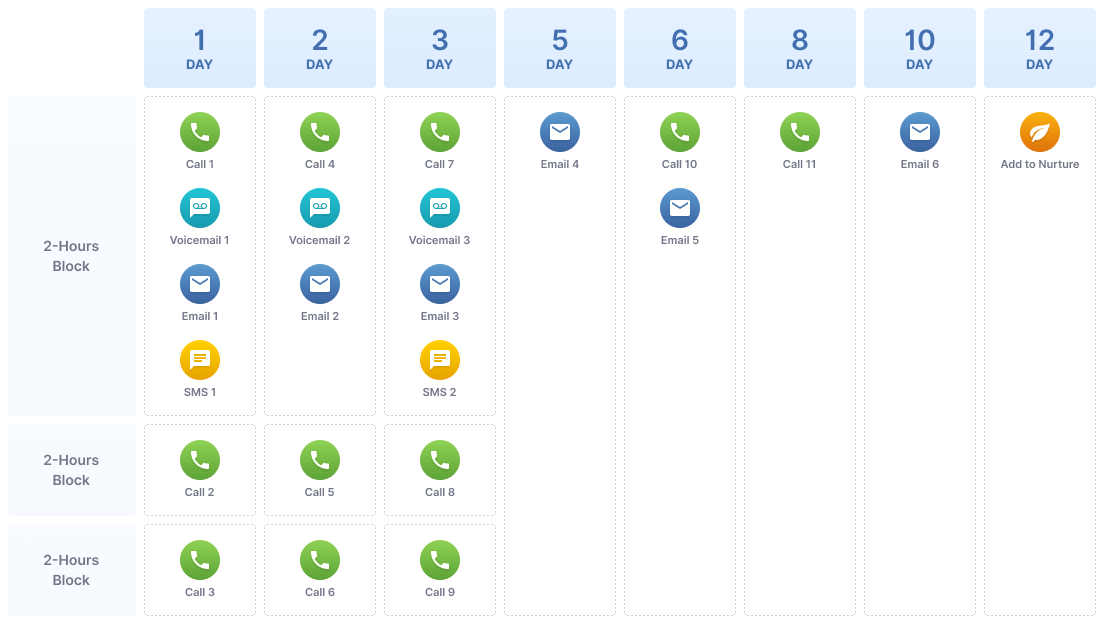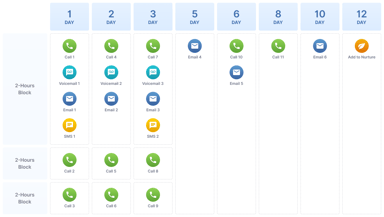Getting Started with Lead Communication Cadences
Organizations adopting new lead management software are often unsure about the sales cadences, including outbound dialing sequences and marketing touchpoints like SMS and email communications. Building strong cadences is critical to effective lead communication. Here are some tips to get you started.
I frequently come across questions such as:
• How many times a day should we call/text/email a lead?
• How long should we wait between each call/text/email?
• What is too much or not enough outbound communication with a lead?
It can be a difficult task to develop compelling cadences. All things considered, the best way to work through this challenge is to understand your buyers motivation and their journey from lead to customer.
Compliance with Federal and Local Laws and Restrictions
An organization must comply with all applicable laws regarding calling, texting, and emailing their leads. When utilizing automated marketing like text and email, you should, at a minimum, include opt-out options for leads to easily request removal from your contact lists. The software solution you use for outbound communication should also provide tools for adhering to state calling restrictions so that your salespeople don’t attempt contact past permitted hours on a state-by-state basis.
Understanding Where Your Leads Come From
The best cadence for effective communication can vary greatly depending on how you source leads.
Internet Sourced Leads
If all of your leads come in from web forms or lead providers, then you should develop a strong focus on speed-to-contact. Internet leads sourced this way are real-time opportunities, prioritize engagement with them to ensure they are reached within seconds. Statistics show that internet leads begin to cool after five minutes and have a 10X decrease in the chances of contact. Speed-to-contact is critical.
At the same time, you shouldn't assault your contacts with a barrage of emails, text messages, and phone calls. Too much outreach in quick succession can be a red flag to the lead. This approach will likely turn them off and you'll lose the them.
A good balance is, one automated text message or email sent to the prospect immediately and one phone call. After that, wait at least a couple of hours before engaging further.
Third-Party Lead Sourcing
If you source your leads from third-party lead providers and you know they are aged leads, the same speed-to-contact is not a priority. Consider that because contacts sourced from third-party lead providers may not be familiar with your organization, an overly aggressive cadence with them may do more harm than good.
If a lead suddenly starts receiving your calls several times a day without knowing who you are, they likely won’t answer. It would be prudent to send an email or text message as a primer to let the lead know who you are and why you are contacting them before you try a phone call. This way, you have the chance to build a rapport and now they are expecting to hear more from you.
Put Yourself in Your Lead's Shoes
Empathy is a powerful tool. Put yourself in the position of one of your leads – you’ve sent your personal information out along with an indication of interest, giving permission to be contacted by a salesperson regarding a product or service. What would you like to happen now that you have submitted your information and shown intent to correspond with a salesperson?
If you, as a consumer, have expressed interest in a company's offering, you would expect contact immediately. The longer a company takes to make contact, the less you'll feel that they are interested in your business. And if you won't respond to a potential sale, what kind of service are you likely to provide?
Consider the opposite: you submit your personal information and immediately receive a text message, an email or two, and a phone call. Receiving too much information at once can be overwhelming without a reasonable time block between contact attempts.
When I’ve experienced this in the past, I’ve ignored the contact request and unsubscribed from further communication from the organization. I have then ignored subsequent calls and even blocked numbers if the attempts continued.
Envisioning the lead in both scenarios is essential. This defines both your first action and also your follow-up. If you have a new lead that you’re unable to connect with, accept that they may be having a busy week. A few emails throughout the week containing helpful information about your organization and how to contact you may remedy the situation.
Consider Opt-Out and Negative Impacts from Too Much Outreach
If you’re making excessive contact, your leads may repeatedly flag your emails as spam. Too many spam flags will cause long-term trouble because email providers will automatically flag future communications as spam.
A similar result can occur with your phone numbers. If leads block your text messaging and outbound dialing numbers, carriers may start identifying your numbers as suspected spam. Some service providers may not allow the call or text message to go through to the recipient. Even the volume of outbound calls you make in a day with a phone number can contribute to the risk of the number being flagged as potential spam.
See: How to Avoid Spam Flagging on Your Outbound Calls
It’s essential to keep these circumstances in mind, as they can have a considerable impact on your likelihood of connecting with your leads.
General Guidelines
A good rule-of-thumb is to keep a one-to-four ratio for contact attempts per day for each lead. Typically, your cadence will have more contact attempts in a shorter time period for newer leads with less attempts as the lead ages. An example of a 30-day cadence could look like this:

With this type of cadence, after 12 days you would stop actively calling the lead and move them into a drip email campaign. In the email drip, they would receive one email a week for two or three weeks, then bi-weekly emails for a couple of months.
As with any rule, there are exceptions. In some industries, six contact attempts on the first day improve contact rates, while it could be the opposite for other businesses. Data will be your best resource, and you will need to test and analyze the results to make impactful adjustments to your process.
Once strong cadences have been built, you'll see how effective it is for lead communication and how much time and effort it can save your sales and marketing teams. The initial effort of building proper cadences will pay for itself in overall efficiency, contact rates and ROI.


